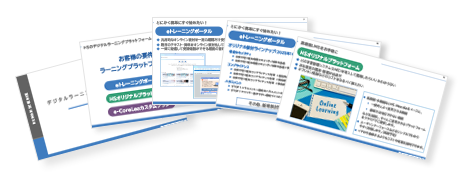2023.07.10
What are the effects of e-learning? Key points to enhance learning effectiveness and considerations after implementation

E-learning, which has revolutionized learning styles and approaches, has expanded its applications more flexibly with technological advancements and is actively utilized in corporate training.
In this article, I would like to organize the effects and benefits of e-learning in corporate training and reconsider the reasons why many users benefit from it.
Furthermore, I will explain the points to enhance the learning effects of e-learning and the considerations to keep in mind after implementation, providing tips and tricks to achieve deeper learning.
Table of Contents
1. Expected Effects and Benefits of Implementing e-Learning
2. To Better Utilize the Learning Effects of e-Learning
3. Points to Note After Implementation - Don't Overlook the "Voices of Dissatisfaction" -
4. Effectively Utilize e-Learning to Improve the Quality of In-House Training
1. Expected Effects and Benefits of Implementing e-Learning
E-learning, with its various attractions such as flexibility, accessibility, and efficiency, provides many users with learning opportunities. In this chapter, we will explain the effects and benefits of implementing e-learning from the perspectives of both administrators and learners.
* For more details on e-learning in corporate training, please refer to this page.
Effects and Benefits for Administrators
(1) Cost Reduction
E-learning eliminates various expenses such as venue rental, maintenance costs, instructor fees, and transportation costs, allowing for significant cost savings compared to in-person group training. Additionally, the digitization of materials and resources eliminates costs associated with printing and distribution. By streamlining various processes, the number of personnel involved in operations can also be reduced, leading to further savings in labor costs.
(2) Efficient Use of Resources
Once learning content and materials are created, they can be reused repeatedly for many learners. Additionally, modifications or updates to the materials can be completed by simply replacing the data, eliminating the need for printing or redistribution, thus reducing effort.
(3) Easy Management and Analysis of Learning
By using an e-learning platform, you can centrally manage learning progress, grades, attendance information, and more. This allows you to grasp the learner's situation and performance in real-time, providing the necessary support and feedback appropriately.
(4) Can provide optimal learning plans for each individual
The e-learning platform also has the capability to collect and analyze learner data and performance. Administrators can understand trends and challenges based on that data, allowing them to provide optimal learning plans and materials. As a result, this leads to improved learning outcomes for each individual.
Effects and Benefits for Learners
(1) Learn without being tied to a specific place or time
You can learn according to your own schedule without being restricted by time or location. By accessing the learning platform, you can easily start learning anywhere, such as while commuting or out and about, making use of your spare time.

(2) Parts that are unclear can be reviewed multiple times
Learners can adjust the pace of their progress. It is possible to repeatedly study difficult parts or to move quickly through sections that have been understood. The ability to learn flexibly according to individual learning styles and abilities is appealing.
(3) Increase Learning Effectiveness with Abundant Content
E-learning offers a wide variety of learning content. Depending on the learning material, you can acquire knowledge through various styles such as videos, audio, interactive materials, and online tests, which can enhance learning effectiveness and boost motivation.

(4) Easy to Understand Learning Progress and Weaknesses
The e-learning platform visualizes learning progress and grades, allowing you to grasp your learning pace and weaknesses. As a result, you can identify areas for improvement and engage in more effective learning.
In this way, it has been found that e-learning offers significant benefits for both administrators and learners. Additionally, it is worth noting that e-learning can also provide opportunities for communication between both parties. Through online forums, chats, and video conferences, learners can interact with instructors and tutors (those who answer questions about the materials) and receive various forms of support, which is very reassuring for them.
Furthermore, administrators can directly hear the "real voices" of learners, enabling them to provide more accurate advice.

E-learning is increasingly gaining prominence as an "evolving learning style" that combines flexibility and efficiency to meet the demands of modern learning.
2. To better utilize the learning effects of e-learning
What points should we be aware of to create a more effective learning environment using e-learning? Here, we will share four key points to enhance learning effectiveness.
Point 1: Selection of the Optimal e-Learning Service

To utilize e-learning, it is common to implement e-learning services provided by various companies. However, even when referring to e-learning services, their features, materials (*), costs, and more can vary greatly. When selecting a service, check the following points and choose the one that best matches your preferences and conditions.
* For details on the characteristics of each material, please refer to this page.
(1) Check Content and Features
E-learning services can be broadly classified into three categories based on their service types.
A. Ready-made materials provided by various companies
B. Users upload materials created in-house
C. Both (A) and (B) can be utilized
When implementing e-learning, carefully consider which service type is suitable for your company and whether the necessary materials are provided. Also, do not forget to check if the required features and specifications, such as learning management items and security, are met.
(2) Check Usability
While it is certainly important to consider "ease of use for learners," usability is also a crucial point for administrators. If the tools are difficult to handle, there is a risk that they will not be utilized effectively, and the learning outcomes may not be fully achieved. First, take advantage of a free trial version to thoroughly check the usability of the e-learning service.
(3) Check Cost-Effectiveness
There are cases where, in focusing too much on functionality and usability, companies end up choosing specifications that exceed their actual needs. In such cases, not only may they be unable to fully utilize the features, but costs can also escalate, leading to lower cost-effectiveness. First, clarify the purpose and goals of implementing e-learning, and be careful not to make unnecessary configurations. Then, it is recommended to choose from services that meet the criteria, selecting those with higher cost-effectiveness.
Point 2: Establish rules and systems regarding participation
Once the e-learning service to be implemented is decided, consider the rules and systems for participation, and establish a framework that is easy to use for both administrators and learners. By setting clear guidelines such as study hours, learning objectives, and support systems, you can provide a high-quality learning environment, which can help reduce the burden and stress on learners. Additionally, creating a system to visualize learning outcomes and a sense of achievement may also enhance motivation for learning and improve performance.
Point 3: Combine with Practical Training
The knowledge and skills acquired through e-learning can be effectively utilized in actual work by combining them with practical training such as exercises and on-the-job training. Learners will be able to leverage their e-learning experience to develop adaptability and application skills. Furthermore, by conducting "knowledge output" through training, the retention of learning can also be improved.

Point 4: Provide follow-up according to the learner's proficiency level
Learners have their own pace and style of learning, and their levels of proficiency vary. Therefore, providing individualized follow-up according to each learner's proficiency and understanding can enhance the effectiveness of learning. By offering specific guidance and advice to resolve the issues and concerns that learners face, the quality of learning improves, which also helps prevent frustration and dropout. In e-learning, where each individual learns autonomously, support for each learner is another key point.
3. Points to Note After Implementation ~ Don't Overlook the 'Voices of Dissatisfaction' ~
After implementing e-learning, administrators may receive various feedback from learners. Among these, there may be voices of dissatisfaction and concerns. However, these voices provide an opportunity to update the learning environment to make it better.
In this chapter, we will pick up common "voices of dissatisfaction" regarding e-learning and introduce methods to resolve these issues.
Voice of Discontent.1: It is difficult to maintain motivation for learning
(Solution Example)
We recommend providing opportunities for communication between learners and instructors.
Let's promote interaction and information sharing through online forums, group discussions, and regular video conferences. This can help clarify any uncertainties and inspire motivation by observing others' learning efforts, contributing to mutual support and encouragement.

Voices of Dissatisfaction.2: There is a lack of content that is directly related to practical work
(Solution Example)
In addition to e-learning, how about incorporating case studies and practical exercises that are relevant to real-world practice into your learning content? By experiencing an environment close to actual business situations, you can enhance your problem-solving and decision-making skills in practice. Additionally, by inviting experienced professionals as guest speakers to appear in learning content and online seminars, you can provide practical knowledge through real explanations.

Voices of Dissatisfaction.3: Difficulty in Self-Management and Creating Study Plans
(Solution Example)
It is important to regularly track and support learners' progress using tools such as learning management systems. By monitoring course completion rates, assignment submission statuses, attendance, and test scores, we can provide more specific advice to help learners progress towards their goals. Additionally, we should be mindful that learning plans can be flexibly adjusted at any time, and create schedules that are manageable and suited to the learners' abilities.

Voice of Dissatisfaction.4 Not Compatible with Mobile
(Solution Example)
Many people use e-learning on mobile devices. Especially busy professionals often utilize their commuting or travel time for learning, making mobile devices, including smartphones, important learning tools. Therefore, mobile compatibility is essential.
If the e-learning platform is not mobile-friendly, consider updating it or implementing an alternative platform.
Additionally, if the content is not optimized for mobile, adapting it to responsive design will allow for comfortable learning from mobile devices.

4. Effectively utilize e-learning to improve the quality of in-house training
In today's business environment, where situations are constantly changing, effective educational and training methods are required to respond to these changes. In this context, the introduction of e-learning can bring significant benefits to companies.
However, simply implementing e-learning will not allow you to fully reap its benefits. It is important to be aware of the points introduced in this article that enhance learning effectiveness, as well as the precautions after implementation, and to provide support from the learner's perspective and improve the learning environment.
Human Science, specializing in the development of educational systems and planning for e-learning, has successfully addressed a wide range of challenges faced by various companies over many years, building a wealth of experience. Based on this proven track record, we will propose practical plans to enhance the quality of in-house training and facilitate employee growth.
First, we would like to hear about your company's challenges and concerns.
Please feel free to contact us.












